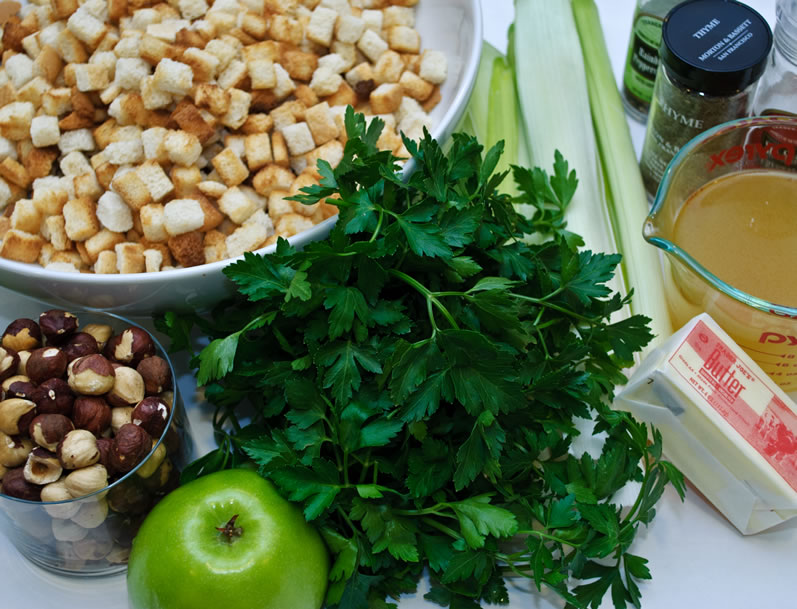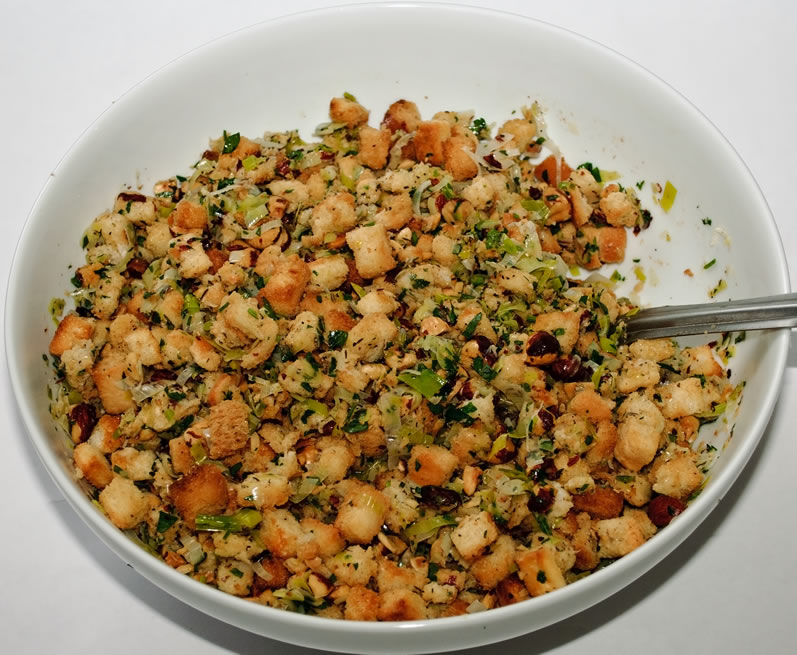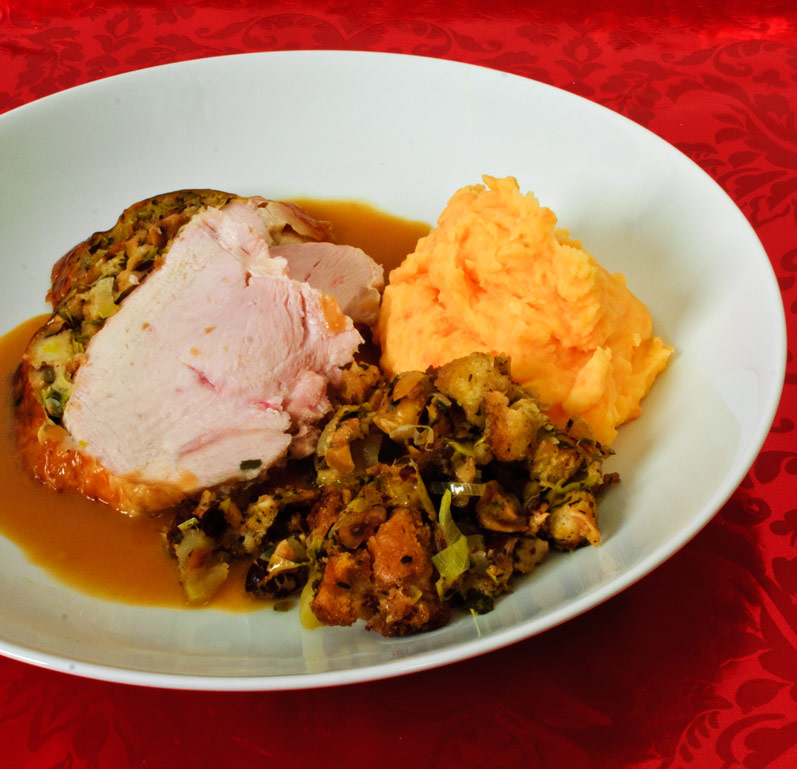Whether you call it stuffing or dressing, it’s the best part of Thanksgiving.

I grew up in a Yankee household with a Southern father. So even though I said “you guys” instead of “Y’all” and didn’t act one bit like a “lady” unless under strict orders accompanied by threat of dire consequences, some Southern mores were passed on to me nonetheless.
For instance, in our Seattle house, stuffing was called dressing, which is what my very lady-like Kentucky born-and-raised Grandmother called it. It didn’t matter if it was baked in the bird or alongside the bird, it was dressing nonetheless. It was served with perfect mashed potatoes (a point of pride for Kentucky cooks) and a silky, roux-based, turkey gravy.
For me as a kid, the turkey always played second fiddle to the stuffing, mashed potatoes, and gravy. Nothing much has changed. I appreciate a slow roasted, brine-cured bird with the Thanksgiving meal, but I enjoy it cold even more, in a sandwich the day after.
That said, when the dressing is what you love most, it has to be “top drawer” as Grandma Macy always put it. This Green Apple Dressing fills the bill. The leeks are cooked down to a melting silkiness and added to the bread, along with toasted hazelnuts, tart apple, and plenty of parsley. The mixture is well seasoned and carefully hydrated, so that the final result is a light (not sodden) dressing, with texture from the nuts and bursts of tartness from the apples.
Although this Green Apple Dressing is a far cry from the traditional version I grew up on, I think my Grandmother would approve nonetheless. And she would be pleased to know that I am hardly ever a “rowdy hooligan” anymore, thanks of course to her wise and patient counsel over the years.
Note About that sandwich: My fave post-Thanksgiving turkey sandwich consists of two thick slices of fresh Italian bread, mayo, a heap of thinly sliced, cold turkey, salt, pepper, cold stuffing, and potato chips. I created it at about 10 years of age and still consider it a masterpiece of ingenuity. Try it with this stuffing.
To complete this festive meal, check out Who’s Afraid of Mashed Potatoes.
Green Apple Dressing with Melted Leeks & Toasted Hazelnuts
This Green Apple Dressing (or stuffing for you Yankees) is light and fluffy and loaded with the flavors of fall.
NOTE: I like to use a loaf of locally made ciabatta bread (Ken’s Artisan Bakery in Portland) for the croutons. Just cut the bread into 1/2-inch cubes a day in advance, arrange in a single layer on a baking sheet and leave out for a day or so to dry.
½ cup unsalted butter (1 stick)
4-6 large leeks, white parts only, cleaned and thinly sliced (1 pound sliced)
8 cups dried bread cubes, about ½-inch cubes (9 ounces)
2 cups lightly toasted hazelnuts, skins removed and coarsely chopped
1 cup Italian parsley, minced
2 cloves garlic, peeled and minced or pressed
2 teaspoons dried thyme, crumbled
1 teaspoon dried sage, crumbled
2 teaspoons freshly ground black pepper
1 teaspoon fine sea salt, plus more to taste
1½-2 cups chicken stock, approximately (will vary considerably depending on size and dryness of bread cubes)
2 Granny Smith apples, peeled, cored, and cut into eighths lengthwise, and then cut into ¼-inch dice
1 tablespoon fresh lemon juice
1 tablespoon sugar
Binder Options
1½-2 cups chicken stock, approximately (will vary considerably depending on size and dryness of bread cubes)
—OR—
1-1½ cups chicken stock, approximately (will vary considerably depending on size and dryness of bread cubes)
2 large eggs
- In a large saute pan, melt the butter and add the leeks. Cook slowly, covered, for about 15 minutes, until the leeks are very tender.
- Remove from heat and add to a large mixing bowl, along with the bread cubes, hazelnuts, parsley, garlic, thyme, and sage.
- Dice apples, add them to a separate mixing bowl, and toss with lemon juice to prevent browning. When all the apples are cut and in the bowl, toss with sugar.
- Fold apples into the stuffing.
- Taste stuffing and season to taste with salt and pepper.
- Drizzle ½ cup of chosen binder over stuffing, tossing gently to incorporate. Wait at least 5 minutes for the bread to absorb the stock and repeat the sequence twice more. You have now added 1½ cups of binder. Taste the stuffing and determine whether to add additional stock. The goal here is a light and fluffy stuffing—not dry and not sodden.
- Now you have two options: You can either bake the stuffing, covered, in an ovenproof casserole in a 350° oven for about 45 minutes, or use it to stuff a turkey or turkey breast. I figure you know how to stuff a turkey, so will give only the procedure for stuffing the breast.
To Stuff a Turkey Breast
- To stuff a turkey breast, turn the breast so that you are looking at the underside. Begin along one side and follow the contour of the breastbone with a small very sharp knife to separate the bone from the breast meat. Cut around obstacles, such as the wishbone and protruding blade. Repeat from the other side of the breast. You should now have the bone completely exposed except for the center ridge.
- To ensure that you do not cut through the skin while you cut the bone from the breast, grab the skin with one hand and pull it away as you carefully make this last cut. With bone removed, turn the breast back over so it’s skin-side-up and pat back into shape.
- Next, insert your hand under the skin and gently pull to loosen it everywhere except the edges. What you want here is securely attached pocket with space for 4 cups of stuffing.
- Measure out 4 cups of stuffing and gently stuff it under the skin. Smooth the skin and pull it taut over the breast.
- Truss the breast loosely with kitchen string and set on a wire rack over a baking pan. Rub unsalted butter over the skin.
- Roast the chicken breast at 350° for about 20 minutes per pound. Pull the breast from the oven when an instant-read thermometer stuck into the thickest portion registers 170 degrees.
- Let the breast rest, covered with foil for 15 minutes before serving. This allows the juices to redistribute evenly through the meat.
Makes enough dressing to stuff a 10-12 pound turkey, or 4 cups to stuff a turkey breast and 8 cups to bake separately.
Cookin’ with Gas (inspiration from around the web)
- About.com: Stuffing History
- Baking Bites: Stuffing vs Dressing, and Regional Preferences
- Wikipedia: Stuffing
Copyright 2010-2018 Susan S. Bradley. All rights reserved.




Sooz: It’s pretty bad when I have to go to you blog to try to find you. Call or email me or else I’ll start sharing some stories about you growing up for the whole world to see. Casey
Hey, I was just wondering what the heck you are up to. It’s YOU who owes ME an email. I’ll write tomorrow and you better write back this time.
I’m a dressing person! Grew up in MD, and that’s what it was called there. This looks delicious. I like my dressing on the fluffy side, too, so I make it outside the turkey. I found most dressings stuffed into the bird is way too soggy. I think it absorbs too much of the turkey jus unless you make it very wet. My Mother always said the dressing stuffed into the bird was just to flavor the turkey and it’s juices anyway, so I never ate it back then. I love it your way, now.
Hi Susan! Thanks so much. One trick I forgot to mention as far as getting max flavor into a stuffing that you intend to bake rather than stuff into the bird is to make a brown turkey stock, reduce it by half and use that for the srtock in the dressing. That way, you get the best of both worlds.
Thanks so much. One trick I forgot to mention as far as getting max flavor into a stuffing that you intend to bake rather than stuff into the bird is to make a brown turkey stock, reduce it by half and use that for the srtock in the dressing. That way, you get the best of both worlds.